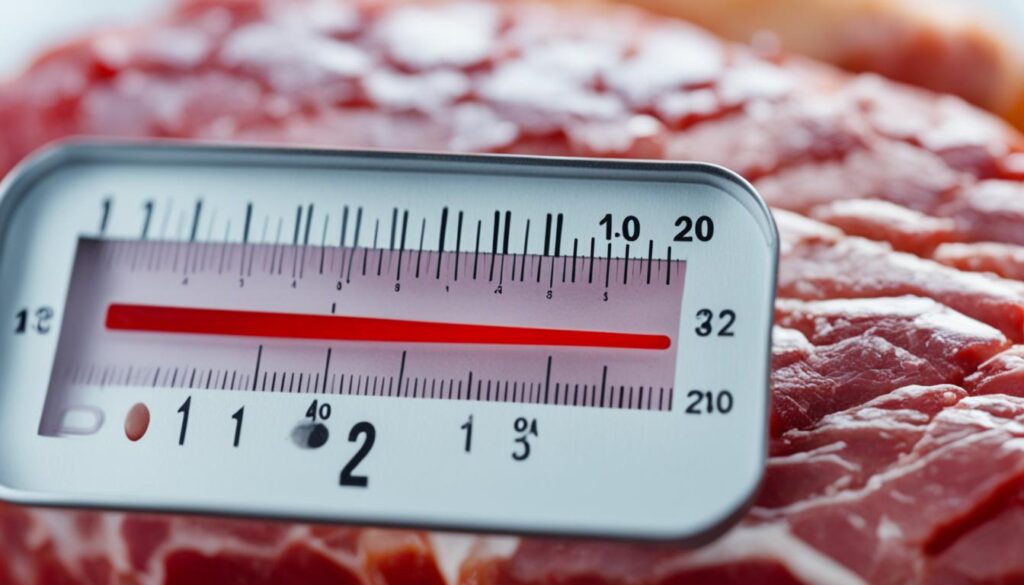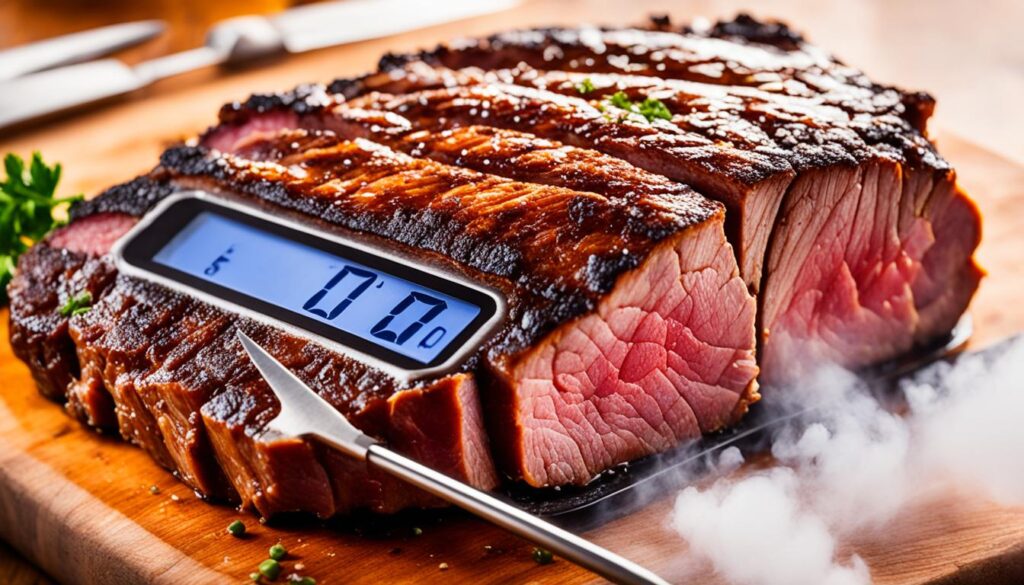Have you ever wondered how professional chefs achieve that perfect level of doneness in their meat every single time? Is there a secret technique or magic trick that they know, while the rest of us struggle to get it right?
Well, the truth is, achieving the ideal doneness in meat is not as elusive as it may seem. It all boils down to one simple tool that every home cook should have in their kitchen: a meat thermometer.
Using a meat thermometer is the key to ensuring that your meat is cooked to perfection, whether you prefer a juicy medium-rare steak or a well-done chicken breast. By measuring the internal temperature of the meat, you can determine exactly when to take it off the heat, resulting in succulent and flavorful dishes every time.
In this article, we will guide you through the process of taking meat temperature with a thermometer and provide you with all the information you need to achieve your desired level of doneness, whether you’re cooking poultry or red meat.
Key Takeaways:
- Using a meat thermometer is the most accurate way to determine the doneness of meat.
- Different types of meat have different ideal temperatures for doneness.
- Knowing where to insert the thermometer is crucial for accurate temperature readings.
- Resting the meat after cooking allows for carryover cooking and juicier results.
- Following recommended cooking temperatures ensures food safety.
Where to Stick the Thermometer
To get an accurate temperature reading, it’s crucial to know where to insert the meat thermometer. The goal is to find the coolest part of the meat, which may not necessarily be the exact center.
Push the thermometer all the way through the meat until it emerges on the other side. Slowly retract the thermometer, and you’ll notice the temperature rise abruptly, then start to drop as you get closer to the center. The lowest temperature reading you encounter is the one you should go by.
Meat Doneness Levels
When it comes to cooking meat, achieving the perfect level of doneness is essential to satisfy different taste preferences. Knowing the ideal meat temperature guide can help you create mouthwatering dishes that are cooked to perfection. Here, we’ll explore the various meat doneness levels and their corresponding meat temperatures.
Rare
Rare is the desired doneness for steak lovers who enjoy a juicy and tender meat with a deep-red center. For red meat, the ideal temperature for rare is at 120°F (49°C).
Medium Rare
Medium rare is a popular choice, providing a perfect balance between tenderness and flavor while still retaining a pinkish-red center. The target temperature for medium rare is around 130°F (54°C).
Medium
For those who prefer a more cooked steak with a slight hint of pink in the center, medium is the preferred doneness level. Medium steak reaches a temperature of 140°F (60°C), resulting in a tender and flavorful meat.
Medium Well
If you enjoy a hint of pinkness in your meat but prefer it to be primarily cooked, medium-well is the way to go. This doneness level is achieved when the meat temperature reaches 150°F (66°C) for a slightly pink and juicy center.
Well-done
Well-done steak is fully cooked, with no pinkness remaining in the center. This level of doneness is achieved when the meat reaches a temperature of 160°F (71°C) or above, resulting in meat that is fully cooked throughout.
When it comes to poultry, the meat doneness levels differ slightly. White meat, such as chicken or turkey, is juiciest when cooked to around 150°F (66°C), whereas dark meat should reach 165°F (74°C) or more for optimal tenderness and flavor.
Remember, it’s essential to remove the meat from the heat source when the thermometer registers 5°F (3°C) lower than your desired doneness. This is because the meat’s internal temperature will continue to rise while resting, ensuring that it reaches the perfect level of doneness.
By following this meat temperature guide and using a meat thermometer doneness chart, you can confidently cook meat to your desired doneness level, ensuring a delightful dining experience every time.
Cooking Meat Based on Thickness
When it comes to cooking meat, the thickness of the cut plays a crucial role in determining the cooking temperature. Thinner cuts, such as steaks or chicken breasts, require extra care due to their slim center section. To ensure accurate temperature readings, we follow the same principles as before, by inserting the meat thermometer all the way through and slowly retracting it. The minimum temperature reading that we encounter is the one to rely on.
For thicker cuts, like roasts, the approach is slightly different. Here, we need to insert the thermometer into the thickest part of the meat, while avoiding contact with any bones or fat. This ensures that we get an accurate reading of the internal temperature, which is essential for determining the doneness of the meat.
| Thickness | Cooking Method | Minimum Internal Temperature |
|---|---|---|
| 1 inch (2.5 cm) | Grilling, broiling, pan-searing | 145°F (63°C) |
| 1.5 inches (3.8 cm) | Oven-roasting, smoking | 145°F (63°C) |
| 2 inches (5.1 cm) | Oven-roasting, smoking | 135°F (57°C) |
| 2.5 inches (6.4 cm) | Oven-roasting, smoking | 130°F (54°C) |
As evidenced by the table above, thicker cuts require lower minimum internal temperatures and longer cooking times. It’s important to adjust the cooking method and time accordingly to ensure that the meat reaches the desired level of doneness.

To summarize, when cooking meat based on thickness, thinner cuts should be treated with extra caution and the minimum temperature reading should be followed. For thicker cuts, the thermometer should be inserted into the thickest part of the meat, away from bones or fat. By paying attention to the thickness and taking accurate temperature readings, we can confidently cook meat to perfection.
Resting and Carryover Cooking
After removing the meat from the heat source, it’s important to let it rest before carving or serving. During the resting period, the temperature of the meat will continue to rise slightly, a phenomenon known as carryover cooking. This ensures that the meat reaches its desired level of doneness uniformly. Resting also allows the meat to retain its juices, resulting in a more flavorful and tender final product.

Resting is a crucial step in the cooking process that shouldn’t be overlooked. It allows the natural juices within the meat to redistribute, resulting in a more succulent and tender texture. Additionally, resting allows the residual heat in the meat to continue cooking the center while the exterior begins to cool.
Carryover cooking occurs because the heat applied to the meat continues to penetrate the center even after it’s removed from the heat source. The internal temperature can rise by a few degrees during the resting period, depending on the thickness of the meat and the cooking method used. For thicker cuts like roasts, the temperature can increase significantly, so it’s important to factor this into the cooking process to achieve the desired level of doneness.
“Resting the meat after cooking is a crucial step that is often overlooked. It allows the juices to redistribute and ensures optimal tenderness and flavor.”
It’s recommended to let the meat rest for about 5 to 10 minutes before carving or serving. This allows enough time for carryover cooking to take place and for the meat to reach its final desired temperature throughout. Keep in mind that the specific resting time may vary depending on the size and type of meat.
Recommended Temperatures by Source
When it comes to cooking meat, it’s essential to follow recommended temperature guidelines to ensure safety and achieve optimal doneness. The United States Department of Agriculture (USDA) provides valuable information on the minimum internal temperatures for different types of meat.
Recommended Cooking Temperatures
According to the USDA, steaks and roasts should be cooked to a minimum internal temperature of 145°F (63°C) for medium doneness. This ensures that the meat is both safe to consume and retains its juiciness. After reaching the recommended temperature, it’s important to let the meat rest for at least three minutes to allow the juices to redistribute and create a more flavorful result.
Ground beef, on the other hand, should be cooked to a minimum temperature of 160°F (71°C) to eliminate any potential health risks associated with harmful bacteria. Ground meats have a larger surface area, making them more susceptible to bacteria growth. By cooking ground beef to the recommended temperature, you can enjoy a delicious and safe meal.
“Color alone is not a reliable indicator of doneness.”
The USDA emphasizes that relying on color alone is not sufficient to determine doneness. The color of cooked meat can vary depending on factors like the cooking method, the type of meat, and the presence of seasonings. Using a meat thermometer is the only accurate way to ensure that your meat has reached the recommended temperature for safe consumption.
USDA Recommended Temperature Chart
| Meat Type | Minimum Internal Temperature | Doneness Level |
|---|---|---|
| Steaks and Roasts | 145°F (63°C) | Medium |
| Ground Beef | 160°F (71°C) | Well-Done |
Remember, these temperatures are the minimum recommended guidelines. If you prefer your meat cooked to a different level of doneness, you can adjust the temperature accordingly. Keep in mind that removing the meat from the heat source when it’s about 5 degrees below your desired temperature allows for carryover cooking. The internal temperature will continue to rise during the resting period, resulting in perfectly cooked meat.
Using the USDA recommended cooking temperatures as a guide ensures that you cook your meat to perfection, guaranteeing both safety and delicious flavor. Don’t leave it to chance; invest in a reliable meat thermometer and follow these guidelines for a memorable dining experience.
Ideal Temperatures for Steak Doneness
Perfecting the temperature for steak doneness is crucial to achieving a delicious and tender steak. Different levels of doneness result in varying textures and flavors, allowing you to choose the one that suits your preferences. Here are the ideal steak temperatures for different levels of doneness:
| Doneness Level | Ideal Temperature Range (°F) | Ideal Temperature Range (°C) |
|---|---|---|
| Rare | 120°F to 125°F | 49°C to 52°C |
| Medium Rare | 130°F to 135°F | 54°C to 57°C |
| Medium | 140°F to 145°F | 60°C to 63°C |
| Medium Well | 150°F to 155°F | 66°C to 68°C |
| Well-Done | 160°F to 165°F | 71°C to 74°C |
When cooking steak, it’s essential to remove it from the heat source when it’s about 5 degrees below your desired temperature. This is because the residual heat will continue cooking the steak, ensuring it reaches the perfect level of doneness without becoming overcooked.
Conclusion
Taking the temperature of meat using a meat thermometer is the most accurate way to ensure perfect doneness. By properly placing the thermometer and knowing the desired cooking temperature for different types of meat, you can achieve the desired results every time. Remember to allow the meat to rest after cooking, as the temperature will continue to rise slightly during this time, a process known as carryover cooking.
Following these guidelines will help you confidently cook meat to perfection, resulting in delicious and safe meals. The meat thermometer is your trusty companion in the kitchen, allowing you to accurately measure the internal temperature of the meat and determine its doneness level. Whether you prefer rare, medium, or well-done, knowing the ideal temperatures for different cuts of meat will help you achieve the perfect result.
So go ahead and invest in a reliable meat thermometer, and you’ll never have to worry about undercooked or overcooked meat again. With the right cooking temperatures and a little resting time, you can enjoy flavorful and tender meat dishes that will impress your family and friends.
